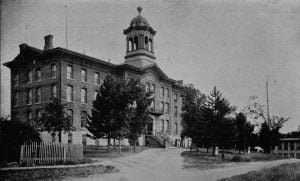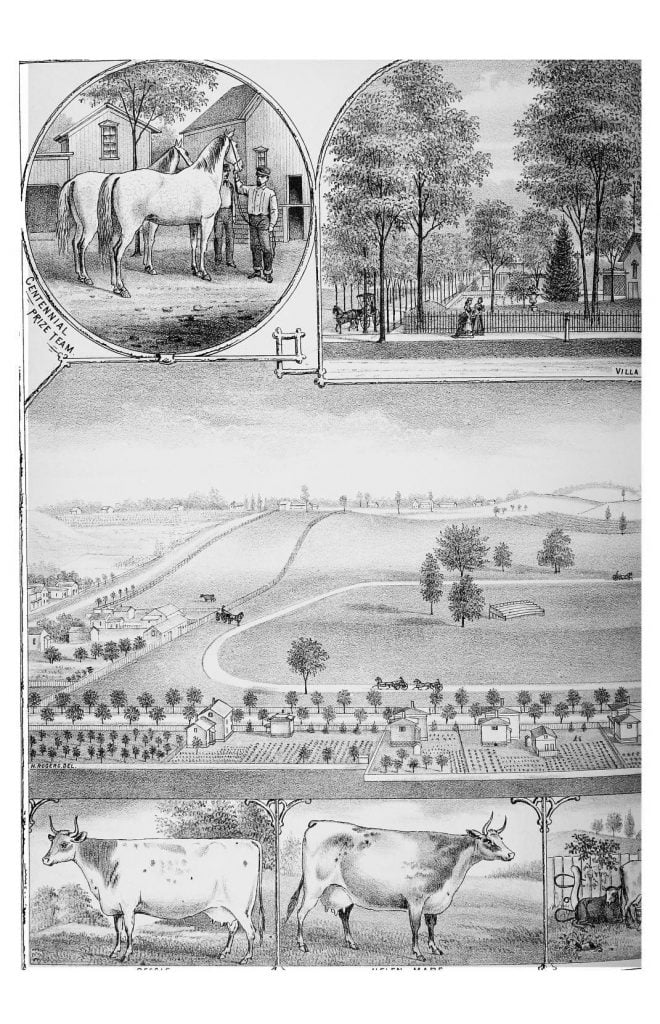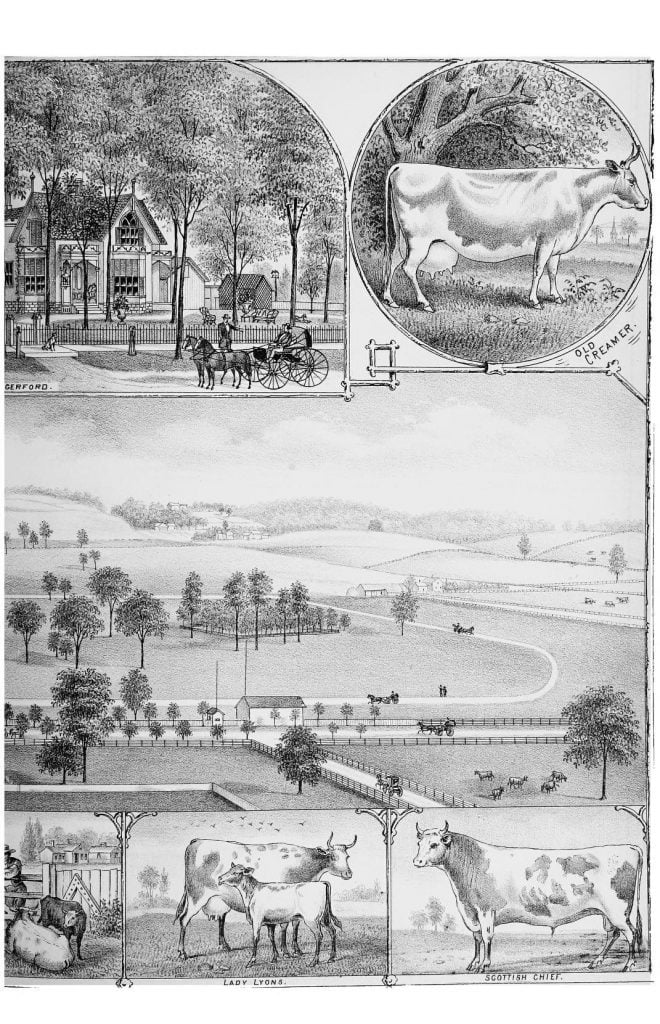General Hungerford, whose history is so intimately connected with that of Jefferson County, and especially of the town of Adams, belongs to a family whose genealogy can be traced for at least two centuries. Thomas Hungerford came from the parish of Shetford, England, thirty or forty miles from London, and went to Hartford, Connecticut, before the year 1639. Mention is made of a descendant of the same name in the Hartford State Records, and in looking over the American Archives we find that one John P. Hungerford was an officer in the Revolution, and member of Congress from 1813 to 1817, and died at Turford, Virginia, at the age of seventy-four.
At the head of the fifth generation we have Dexter Hungerford who married Marietta Burr, to whom were born five children. The history of the Burr branch of the family is a remarkable one, including the famous Aaron Burr, and other men of genius.
The third of this family, the subject of our sketch, was born March 12, 1808. His earliest home was on a farm in Watertown. He entered the dry goods store of Mr. Adriel Ely at the age of fifteen, which proved a business discipline of great service in shaping his successful financial career.
After remaining in this position for four years, he decided to prepare for a collegiate course, but, upon the ad-vice of his kinsman, Hon. Orville Hungerford, he took the position of book-keeper in the Jefferson County bank for a year. At the expiration of that time he was promoted to the position of teller, which office he held for eight years, when he was elected cashier of Lewis County bank, at Martinsburg. At the end of two years he was urged by his friend, Mr. Ely, and his uncle, Hon. Orville Hungerford, to go into banking on his own account, under the general banking law of 1838.
Through the influence and at the urgent invitation of his friend, Robert B. Doxtater, and other leading citizens, he was induced to found an institution at Adams, Jefferson County, called Hungerford’s bank, with a capital of fifty thousand dollars, October 25, 1845, which he successfully conducted as an individual bank till September, 1853, when the capital was increased to one hundred and twenty-five thousand dollars, with the same name, and under a board of directors of which General Hungerford was president. The Bankers’ Magazine, after a notice warmly commending the management of the Hungerford National bank, as it became under the national banking law, mentions a “remarkable fact connected with the history of Hungerford’s bank. It has never suspended specie payments during its existence of upwards of twenty years, having honored every and all demands in coin, till the advent of greenbacks, in 1861.”
Mr. Hungerford is probably the oldest banker in the State, although scarcely beyond middle age, and has no superior in the successful management of this complicated business. For clearness of judgment, pleasing address, and, beyond all, honest and reliable financial management, he is equally remarkable.
His love for agriculture has always been intense, both from the real pleasure it afforded and the beneficial influence upon his health, while it was intimately connected with his business operations.
He has for many years been closely identified with the Jefferson County and New York State Agricultural societies. For sixteen years he was on the executive board of the State society, and finally took the chair of president. His “Valley Park Farm” is one of the most beautiful in the State. On this he keeps one of the best herds of thoroughbred Ayrshire cattle in the United States, and has been largely engaged in importing and breeding these favorites; also ” short-horns,” Leicester sheep, and York-shire swine; and is now devoting much attention to rearing horses, having a just appreciation of this prince among animals. The Boston Cultivator, May, 1863, mentions a particularly fine group of cattle on the Hungerford estate.
Railroad interests claimed a share of Mr. Hungerford’s time and attention. His generous enterprise found scope in this direction during the first attempts to connect the northern part of the State with the great thoroughfares and commercial centers.
Both money, time, and influence were always at command. In 1855 he was elected a director of the Rome and Watertown railroad, at the earnest desire of such men as Philip Dater, of New York; and later of the Rome, Watertown and Ogdensburgh railroad. He was complimented by the capitalists interested, for his substantial improvements in the management of the road. The sound judgment and integrity seen here, as in all other financial concerns, received a significant testimonial in an incident, one among many, gleaned from a private letter addressed to a personal friend by one for years previous bitterly prejudiced against Mr. Hungerford.
In this the writer alludes to certain differences of opinion existing between Mr. Hungerford and himself, and states as his motive for voting for the former’s re-election, his “fearless” discharge of duty in a position where so much “knavery and dishonesty” exists.
But a higher object than business enterprise and success was at Mr. Hungerford’s heart.

Since 1836, when engaged in banking, “the idea of establishing a first-class educational institution in my native country has been very much on my mind,” says Mr. Hungerford in reply to the question as to just when his attention was drawn to the greatest achievement of his life, the founding of Hungerford Collegiate Institute; whose splendid position among the literary establishments of the land is a joy to his own heart and an honor to his native State. An attempt was made about the year 1855 to erect the proper buildings and put the plan into operation, but owing to disagreement as to the site of the prospective edifice, the whole thing fell through for the time being. But in 1864 a large building, erected for hotel purposes, fell into Mr. Hungerford’s hands; this he offered to donate to a board of trustees selected from the several neighboring churches, consisting of twenty-four, provided the citizens would raise an endowment fund of ten thousand dollars, the interest to be devoted to the payment of insurance, repairs, etc. The offer was accepted, a charter secured, and the institute put in successful operation for three years, when the building was burned down.
Another site being obtained with the insurance money, avails of the old lot, and contributions to the amount of over eighty thousand dollars, the present structure was erected.
At the opening of the first institute referred to, the exercises were of an unusually interesting character. Special trains were run to the village from neighboring places. General “Joe” Hooker being among the guests. These were welcomed by Rev. Mr. Hobart, in behalf of the trustees, and escorted by the Watertown Cornet Band to Jackson Hall.
After music and congratulatory addresses, Dr. Fisher, President of Hamilton College, delivered the inaugural address.
The school opened with one hundred and sixty students; and the promise given by its dawn was fulfilled in the years that followed, when it shed the light cf an enlightening and refining influence over the surrounding country.
A most interesting account of the dedication of the new and elegant buildings erected subsequent to the fire is given by the press. We quote a few extracts:
“On Wednesday, August 24, was consummated in Adams the great public enterprise of the village and town. Its beginning and progress have been signalized by great liberality, clear foresight, excellent taste and judgment, and untiring energy.
“The old institute building having been burnt some time ago, it was resolved to build a new one, and part of the means was at hand for the purpose. A commanding site was selected, a plan drafted with careful deliberation, and the structure commenced. The design was purposely for something superior and costly, — something not easy to excel as an educational institute. It was rightly believed that a way would be found to complete it when the money in possession should be exhausted. The work at length had to be stopped. Estimates called for two thousand five hundred dollars more, and how should it be raised ?”
Finally, after efforts in other directions, General Hungerford offered to double whatever sum might be raised. Pledges were soon gained for fifteen thousand dollars, which, with the founder’s generous offer, made thirty thousand dollars; this, combined with the amount in the treasury, gave funds for a one hundred thousand dollar building. The elegant stone and brick building of to-day, with its admirable conveniences and great beauty, is the result.
It is heated with steam and lighted by gas. Hot and cold water can be drawn in each story, and there are bath-rooms for both the gentleman’s and ladies’ divisions. In the library and main hall, etc., is beautiful inlaid flooring of white and dark wood alternating.
At the dedication Rev. S. S. U. Greeley was the speaker of the day; he was followed by citizens and invited guests. General Hungerford, owing to previous illness, took no part in the exercises, but, after loud and renewed applause, came out of the ante-room in response to a call from the audience. He simply bowed and retired.
Mr. Hungerford’s military career dates back to the year 1835; when quite a young man he was commissioned aide-de-camp to the brigadier-general of the Fifty-fifth brigade of infantry. He was subsequently inspector of the Twelfth division of infantry. In 1853 he became captain of infantry in the Thirty-sixth regiment, and brigadier-general of the Eighteenth brigade of the Fourth division of New York State militia in 1859. In 1861, when the Rebellion broke out. General Hungerford, commanding the Sixteenth brigade, and also commissioned to inspect volunteer companies, was loyal to his trust and untiring in his efforts to co-operate with the government. He won the grateful recognition of the State and of his fellow-citizens at home. Mr. Hungerford’s political career was made by himself, — a brief one, beyond his influence in connection with business and social relations, and his prompt action when it was needed as a citizen. He was by nature and education of the conservative clarity, was the cause of his nomination to Congress by the Coalitionists of the Twentieth district in 1866, when an effort was made to defeat the ruling party by a combination of all those dissatisfied with its measures. Mr. Hungerford declined the nomination in a letter which was consistent with his principles, dignified and loyal, an honor to his head and heart.
But in no position has he been more honored and useful, although attracting less popular interest, than when president of the Jefferson County Bible Society, an office he held for several years.
In his domestic relations Mr. Hungerford has been most happy. He married Miss Ann Huntington, of Watertown, who is still the light of a home blessed with a son who gives promise of worthily bearing the ancestral name.
Mr. Hungerford has always liberally and wisely, we believe, sustained the cause of religion in the community, and freely aided the church and parish of which he is a member.
Neither he nor his friends claim for him exemption from human frailties and mistakes; but his fellow-citizens of the town and county in which his life has been so far spent will give him a place among the greatest benefactors of both.
Source: Durant, Samuel W. and Henry B. Peirce. History of Jefferson County, New York, With Illustrations and Biographical Sketches of Some of its Prominent Men and Pioneers. Philadelphia: L.H. Everts & Co., 1878. p 261-263.


